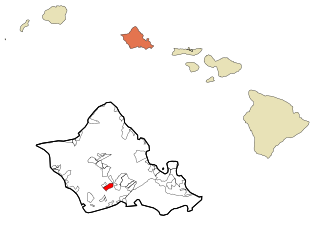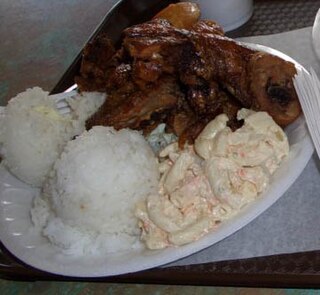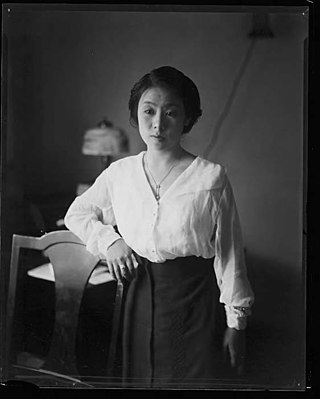
Hawaii is an island state of the United States, in the Pacific Ocean about 2,000 miles (3,200 km) southwest of the U.S. mainland. It is the only state not on the North American mainland, the only state that is an archipelago, and the only state in the tropics.

Waipahu is a former sugarcane plantation town and now census-designated place (CDP) located in the ʻEwa District on the island of Oʻahu in the City & County of Honolulu, Hawaiʻi, United States. As of the 2020 census, the CDP population was 43,485. The U.S. postal code for Waipahu is 96797.

Asian Americans are Americans of Asian ancestry. Although this term had historically been used for all the indigenous peoples of the continent of Asia, the usage of the term "Asian" by the United States Census Bureau only includes people with origins or ancestry from the Far East, Southeast Asia, and the Indian subcontinent and excludes people with ethnic origins in certain parts of Asia, including West Asia who are now categorized as Middle Eastern Americans. Furthermore, Central Asians are not mentioned in any census racial category. The "Asian" census category includes people who indicate their race(s) on the census as "Asian" or reported entries such as "Chinese, Indian, Bangladeshi, Filipino, Vietnamese, Indonesian, Korean, Japanese, Pakistani, Malaysian, and Other Asian". In 2020, Americans who identified as Asian alone (19,886,049) or in combination with other races (4,114,949) made up 7.2% of the U.S. population.

The Japanese diaspora and its individual members, known as Nikkei (日系) or as Nikkeijin (日系人), comprise the Japanese emigrants from Japan residing in a country outside Japan. Emigration from Japan was recorded as early as the 15th century to the Philippines, but did not become a mass phenomenon until the Meiji period (1868–1912), when Japanese emigrated to the Philippines and to the Americas. There was significant emigration to the territories of the Empire of Japan during the period of Japanese colonial expansion (1875–1945); however, most of these emigrants repatriated to Japan after the 1945 surrender of Japan ended World War II in Asia.
The terms multiracial people or mixed-race people refer to people who are of more than one race and the terms multi-ethnic people or ethnically mixed people refer to people who are of more than one ethnicity. A variety of terms have been used both historically and presently for mixed-race people in a variety of contexts, including multiethnic, polyethnic, occasionally bi-ethnic, Métis, Muwallad, Coloured, Dougla, half-caste, ʻafakasi, mestizo, mutt, Melungeon, quadroon, octoroon, sambo/zambo, Eurasian, hapa, hāfu, Garifuna, pardo, and Gurans. A number of these terms are now considered offensive, in addition to those that were initially coined for pejorative use. "Melezi" are called the offspring of Muslim Romani men and woman of host populations.

The plate lunch is a quintessentially Hawaiian meal, roughly analogous to Southern U.S. meat-and-threes. The combination of American and pan-Asian influence makes the plate lunch unique to Hawaii.
The Chinese in Hawaii constitute about 4.7% of the state's population, most of whom (75%) are Cantonese people with ancestors from Zhongshan in Guangdong. This number does not include people of mixed Chinese and Hawaiian descent. If all people with Chinese ancestry in Hawaii are included, they form about 1/3 of Hawaii's entire population. As United States citizens, they are a group of Chinese Americans. A minority of this group have Hakka ancestry.

The Japanese in Hawaii are the second largest ethnic group in Hawaii. At their height in 1920, they constituted 43% of Hawaii's population. They now number about 16.7% of the islands' population, according to the 2000 U.S. Census. The U.S. Census categorizes mixed-race individuals separately, so the proportion of people with some Japanese ancestry is likely much larger.
The term picture bride refers to the practice in the early 20th century of immigrant workers in Hawaii and the West Coast of the United States and Canada, as well as Brazil selecting brides from their native countries via a matchmaker, who paired bride and groom using only photographs and family recommendations of the possible candidates. This is an abbreviated form of the traditional matchmaking process and is similar in a number of ways to the concept of the mail-order bride.

Puerto Rican migration to Hawaii began when Puerto Rico's sugar industry was devastated by two hurricanes in 1899. The devastation caused a worldwide shortage in sugar and a huge demand for the product from Hawaii. Consequently, Hawaiian sugarcane plantation owners began to recruit the jobless, but experienced, laborers from Puerto Rico. In thirteen separate groups, 5883 Puerto Rican men, women and children traveled by ship, train then ship again to the islands of Hawaii to begin their new lives in the sugar plantations.
Asian immigration to the United States refers to immigration to the United States from part of the continent of Asia, which includes East Asia, South Asia, and Southeast Asia. Asian-origin populations have historically been in the territory that would eventually become the United States since the 16th century. The first major wave of Asian immigration occurred in the late 19th century, primarily in Hawaii and the West Coast. Asian Americans experienced exclusion, and limitations to immigration, by the United States law between 1875 and 1965, and were largely prohibited from naturalization until the 1940s. Since the elimination of Asian exclusion laws and the reform of the immigration system in the Immigration and Nationality Act of 1965, there has been a large increase in the number of immigrants to the United States from Asia.

The United States has a racially and ethnically diverse population. At the federal level, race and ethnicity have been categorized separately. The most recent United States census recognized five racial categories, as well as people who belong to two or more of the racial categories. The United States also recognizes the broader notion of ethnicity. The 2000 census and 2010 American Community Survey inquired about the "ancestry" of residents, while the 2020 census allowed people to enter their "origins". The Census Bureau also classified respondents as either Hispanic or Latino, identifying as an ethnicity, which comprises the minority group in the nation.

Sugarcane was introduced to Hawaiʻi by its first inhabitants in approximately 600 AD and was observed by Captain Cook upon arrival in the islands in 1778. Sugar quickly turned into a big business and generated rapid population growth in the islands with 337,000 people immigrating over the span of a century. The sugar grown and processed in Hawaiʻi was shipped primarily to the United States and, in smaller quantities, globally. Sugarcane and pineapple plantations were the largest employers in Hawaiʻi. Today the sugarcane plantations are gone, production having moved to other countries.
Mexican settlement in the Philippines comprises a multilingual Filipino ethnic group composed of Philippine citizens with Mexican ancestry. The immigration of Mexicans to the Philippines dates back to the Spanish period.

Asian American history is the history of ethnic and racial groups in the United States who are of Asian descent. The term "Asian American" was an idea invented in the 1960s to bring together Chinese, Japanese, and Filipino Americans for strategic political purposes. Soon other groups of Asian origin, such as Korean, Indian, and Vietnamese Americans were added. For example, while many Chinese, Japanese, and Filipino immigrants arrived as unskilled workers in significant numbers from 1850 to 1905 and largely settled in Hawaii and California, many Vietnamese, Cambodian, and Hmong Americans arrived in the United States as refugees following the Vietnam War. These separate histories have often been overlooked in conventional frameworks of Asian American history.
Hawaii has been a notable destination for Korean immigration to the United States since the early 20th century.
Asian people are the people of Asia. The term may also refer to their descendants. According to the Merriam-Webster dictionary, an Asian is “a person of Asian descent”.
People of Filipino descent make up a large and growing part of the State of Hawaii's population. In 2000 they were the third largest ethnic group and represented 22.8% of the population, but more recently, according to the 2010 United States Census data indicates they have become the second largest ethnicity in Hawaii, after Whites.
Portuguese immigration to Hawaii began in 1878 when laborers from Madeira and the Azores migrated there to work in the sugarcane plantations. By the end of 1911, nearly 16,000 Portuguese immigrants had arrived.

Spanish immigration to Hawaii began in 1907 when the Hawaiian government and the Hawaiian Sugar Planters' Association (HSPA) decided to supplement their ongoing importation of Portuguese workers to Hawaii with workers recruited from Spain. Importation of Spanish laborers, along with their families, continued until 1913, at which time more than 9,000 Spanish immigrants had been brought in, most recruited to work primarily on the Hawaiian sugarcane plantations.











